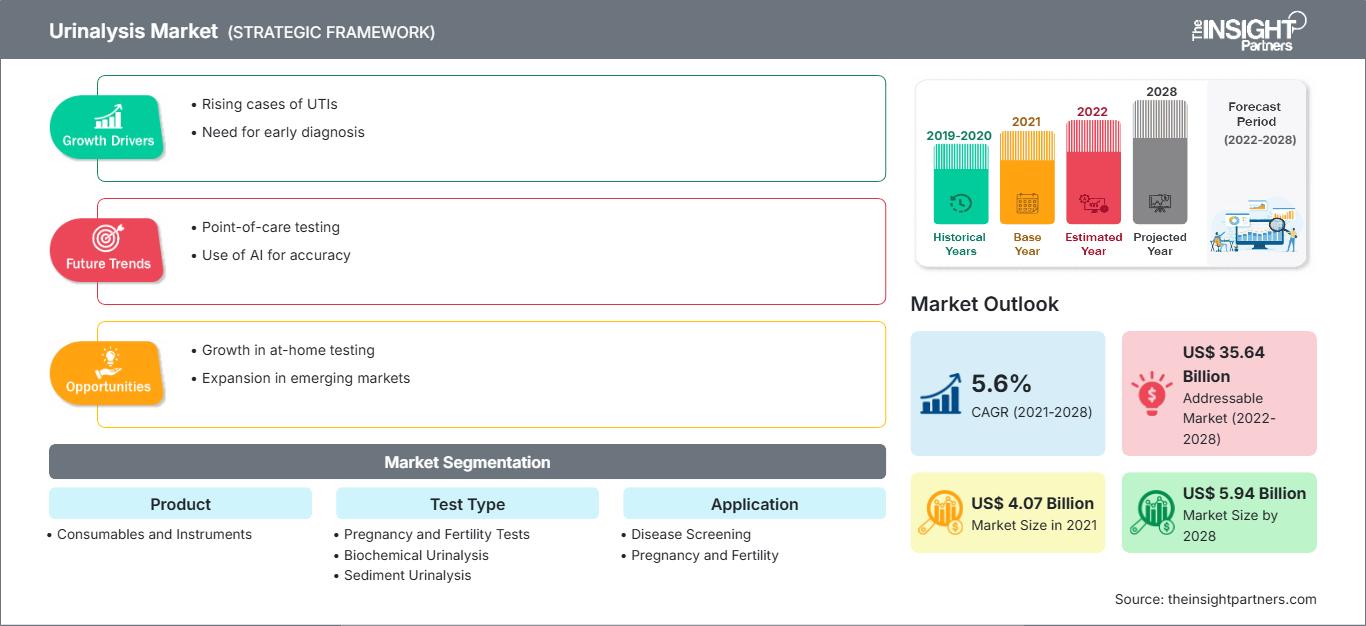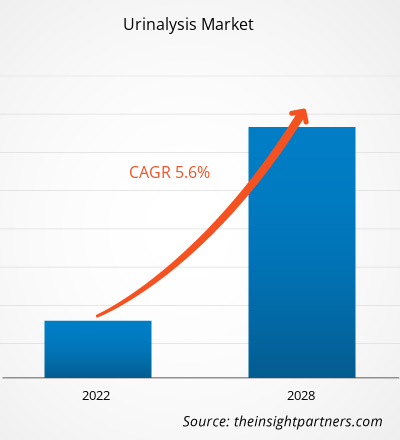Se prevé que el mercado de análisis de orina alcance los 5.937,97 millones de dólares estadounidenses en 2028, frente a los 4.065,79 millones de dólares estadounidenses en 2021; se espera que crezca a una tasa de crecimiento anual compuesta (TCAC) del 5,6% entre 2021 y 2028.
El análisis de orina se utiliza en el diagnóstico y tratamiento de diversos trastornos, como la enfermedad renal, las infecciones del tracto urinario y la diabetes. Consiste en el análisis de la orina mediante métodos químicos, físicos y microscópicos para detectar la presencia de fármacos y sustancias relacionadas con enfermedades, incluidas biomoléculas u otros subproductos. El análisis de orina incluye la comprobación de la concentración, el aspecto y el contenido de la orina. Los resultados anormales o valores fuera del rango esperado pueden indicar una enfermedad. Si el resultado es positivo, puede indicar que los riñones no están funcionando correctamente o que no están filtrando la sangre adecuadamente. También puede ser útil para el diagnóstico de enfermedades cardiovasculares y para la detección del embarazo y la ovulación.
El mercado de análisis de orina se ha segmentado según el producto, el tipo de prueba, la aplicación, el usuario final y la geografía. Geográficamente, se divide principalmente en Norteamérica, Europa, Asia Pacífico, Oriente Medio y África, y Sudamérica y Centroamérica. El informe ofrece información y un análisis exhaustivo del mercado de análisis de orina, haciendo hincapié en parámetros como las tendencias del mercado, los avances tecnológicos y la dinámica del mercado, además de un análisis del panorama competitivo de los principales actores del mercado a nivel mundial.
Obtendrá personalización gratuita de cualquier informe, incluyendo partes de este informe, análisis a nivel de país y paquetes de datos de Excel. Además, podrá aprovechar excelentes ofertas y descuentos para empresas emergentes y universidades.
Mercado de análisis de orina: Perspectivas estratégicas

- Obtenga las principales tendencias clave del mercado que se describen en este informe.Esta muestra GRATUITA incluirá análisis de datos, que abarcarán desde tendencias de mercado hasta estimaciones y pronósticos.
Perspectivas del mercado
El aumento de la carga de infecciones del tracto urinario, diabetes y enfermedades renales impulsa el crecimiento del mercado de análisis de orina
Según un estudio publicado en 2020 por un grupo de investigadores del Colegio Estadounidense de Médicos y la Sociedad Estadounidense de Enfermedades Infecciosas, aproximadamente 6 millones de personas en Estados Unidos acuden al médico cada año para recibir tratamiento por infecciones del tracto urinario (ITU). Las mujeres tienen un mayor riesgo de desarrollar ITU que los hombres. De acuerdo con un estudio publicado en la Revista Internacional de Investigación Ambiental y Salud Pública en 2019, los pacientes con enfermedades crónicas preexistentes, como la diabetes mellitus (DM), tienen un mayor riesgo de contraer ITU. La demanda de componentes necesarios para el análisis de orina está aumentando debido a la prevalencia de la diabetes en todo el mundo, ya que la prueba de detección primaria de la diabetes incluye un análisis de orina. Según la Federación Internacional de Diabetes (FID), aproximadamente 463 millones de adultos (de 20 a 79 años) en el mundo vivían con diabetes en 2019. Se prevé que esta cifra aumente a 700 millones para 2045. Según la IDF, en 2019, aproximadamente 87,6 millones de adultos de entre 20 y 79 años vivían con diabetes en el sudeste asiático, lo que representa una prevalencia regional del 8,8%. De estos casos, aproximadamente el 56,7% no estaban diagnosticados, lo que demuestra el potencial de desarrollo del mercado del análisis de orina. Además, según un estudio publicado por la Fundación Nacional del Riñón en 2020, aproximadamente el 35,0% de la población diabética mayor de 20 años desarrollaría enfermedades renales crónicas durante ese período. El continuo aumento de la prevalencia del cáncer de próstata y vejiga plantea una necesidad imperiosa de implementar diagnósticos altamente eficaces.
Por lo tanto, la creciente prevalencia de infecciones urinarias, diabetes y enfermedades renales impulsa el crecimiento del mercado de análisis de orina.
Información basada en el producto
Según el tipo de producto, el mercado de análisis de orina se divide en consumibles e instrumentos. Se prevé que el segmento de consumibles ostente una mayor cuota de mercado en 2021 y que registre una mayor tasa de crecimiento anual compuesto (TCAC) durante el período de pronóstico.
Información basada en el tipo de prueba
El mercado de análisis de orina, según el tipo de prueba, se segmenta en pruebas de embarazo y fertilidad, análisis bioquímico de orina y análisis de sedimento urinario. Se prevé que el segmento de análisis bioquímico de orina ostente la mayor cuota de mercado en 2021 y registre la mayor tasa de crecimiento anual compuesto (TCAC) entre 2021 y 2028.
Información basada en aplicaciones
Según su aplicación, el mercado de análisis de orina se segmenta en detección de enfermedades y embarazo y fertilidad. Se prevé que el segmento de detección de enfermedades represente la mayor cuota de mercado en 2021. Asimismo, se estima que este segmento crecerá a una tasa de crecimiento anual compuesta (TCAC) superior entre 2021 y 2028.
Información basada en el usuario final
El mercado de análisis de orina, según el usuario final, se segmenta en hospitales y clínicas, laboratorios de diagnóstico, atención domiciliaria y laboratorios e institutos de investigación. Se prevé que el segmento de hospitales y clínicas ostente la mayor cuota de mercado en 2021, mientras que se estima que el segmento de laboratorios de diagnóstico registre la mayor tasa de crecimiento anual compuesto (TCAC) durante el período de pronóstico.
La COVID-19 ha representado la emergencia sanitaria mundial más importante hasta la fecha. Los confinamientos derivados de la pandemia provocaron que la población pospusiera sus revisiones médicas, lo que afectó al número de pruebas realizadas y a las ventas de instrumental, consumibles y reactivos. El mercado de análisis de orina experimentó una caída al inicio de la crisis de la COVID-19 debido a la interrupción de la cadena de suministro y a la disminución de la demanda provocada por los confinamientos decretados por la mayoría de los países europeos. Sin embargo, se observa un repunte en el número de pruebas a medida que los países flexibilizan gradualmente las restricciones de movilidad.
Las adquisiciones, colaboraciones, alianzas, lanzamientos de productos y expansiones son estrategias comunes que adoptan las empresas para ampliar su presencia mundial y satisfacer la creciente demanda. Los actores del mercado de análisis de orina han adoptado principalmente la estrategia de innovación de productos para atender las cambiantes demandas de los clientes en todo el mundo, lo que también les ayuda a mantener su prestigio de marca a nivel global.
Perspectivas regionales del mercado de análisis de orina
Los analistas de The Insight Partners han explicado en detalle las tendencias regionales y los factores que influyen en el mercado de análisis de orina durante el período de previsión. Esta sección también analiza los segmentos del mercado de análisis de orina y su distribución geográfica en Norteamérica, Europa, Asia Pacífico, Oriente Medio y África, y Sudamérica y Centroamérica.
Alcance del informe de mercado de análisis de orina
| Atributo del informe | Detalles |
|---|---|
| Tamaño del mercado en 2021 | 4.070 millones de dólares estadounidenses |
| Tamaño del mercado para 2028 | 5.940 millones de dólares estadounidenses |
| Tasa de crecimiento anual compuesto global (2021 - 2028) | 5,6% |
| Datos históricos | 2019-2020 |
| período de previsión | 2022-2028 |
| Segmentos cubiertos | Por producto
|
| Regiones y países cubiertos | América del norte
|
| Líderes del mercado y perfiles de empresas clave |
|
Densidad de los participantes en el mercado de análisis de orina: comprensión de su impacto en la dinámica empresarial
El mercado de análisis de orina está creciendo rápidamente, impulsado por la creciente demanda de los usuarios finales debido a factores como la evolución de las preferencias de los consumidores, los avances tecnológicos y una mayor conciencia de los beneficios del producto. A medida que aumenta la demanda, las empresas amplían su oferta, innovan para satisfacer las necesidades de los consumidores y aprovechan las nuevas tendencias, lo que impulsa aún más el crecimiento del mercado.

- Obtenga una visión general de los principales actores del mercado de análisis de orina
Perfiles de empresas
- Abbott
- Laboratorios ACON, Inc.
- ARKRAY, Inc.
- Beckman Coulter, Inc.
- Laboratorios Bio-Rad Inc.
- Cardinal Health Inc
- F. Hoffmann-La Roche Ltd.
- Corporación Quidel
- Siemens Healthineers AG
- Corporación Sysmex
- Análisis histórico (2 años), año base, pronóstico (7 años) con CAGR
- Análisis PEST y FODA
- Tamaño del mercado, valor/volumen: global, regional y nacional
- Industria y panorama competitivo
- Conjunto de datos de Excel
Informes recientes
Testimonios
Razón para comprar
- Toma de decisiones informada
- Comprensión de la dinámica del mercado
- Análisis competitivo
- Información sobre clientes
- Pronósticos del mercado
- Mitigación de riesgos
- Planificación estratégica
- Justificación de la inversión
- Identificación de mercados emergentes
- Mejora de las estrategias de marketing
- Impulso de la eficiencia operativa
- Alineación con las tendencias regulatorias




















 Obtenga una muestra gratuita para - Mercado de análisis de orina
Obtenga una muestra gratuita para - Mercado de análisis de orina